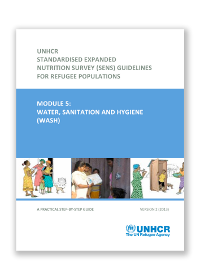OBJECTIVES
The SENS WASH survey questions aim to measure the following priority indicators at household level:
- Use of an adequate quantity of water
- Access to an improved drinking water source
- Safe excreta disposal practices
The objective is as follows:
- To determine the population’s access to, and use of, improved water and sanitation and hygiene facilities.
INDICATORS
Specific Objectives
- To determine the proportion of households that use an improved drinking water source
- To determine the proportion of households that use a covered or narrow necked container for storing their drinking water
- To determine the proportion of households that use an adequate quantity of water per person per day
- To determine the proportion of households who say they are satisfied with the water supply
- To determine the proportion of households using an improved excreta disposal facility
- To determine the proportion of households with children under three years old whose (last) stools were disposed of safely
KEY MESSAGES
- The inclusion of the basic WASH module in the nutrition survey will provide key information for planning interventions to address public health concerns and to ensure that basic rights are upheld.
- Poor water, sanitation and hygiene have serious consequences for the health and nutrition status of persons of concern to UNHCR.
- The WASH module provides only the core quantitative indicators for monitoring WASH programmes at the household level and should be used in conjunction with more detailed qualitative assessments undertaken by WASH specialists.
- The majority of questions for the household survey are taken from the UN Joint Monitoring Programme for Water and Sanitation that seeks to harmonise the surveys undertaken in the sector. The harmonisation of survey instruments and survey design can allow for comparison between e.g. national populations and refugee populations.
- On the standardised SENS WASH questionnaire, the questions on water source and sanitation facilities offer a detailed choice of technologies to choose from but it is only necessary to list the options applicable for the specific context that is being assessed (The wording of the actual questions should not be changed).
CAUTION!
The definition of latrines or toilet facilities often causes some confusion when SENS results are released. It is important not to confuse the sanitation facility definition (improved versus unimproved) with the various classifications based on definition and on sharing used in refugee contexts, as explained below.
Sanitation facility definition:
- An “improved” sanitation (toilet) facility is one that hygienically separates human excreta from human contact. The types of technology that are likely to meet this criterion are: flush to piped sewer system; flush to septic tank; flush/pour flush to pit; composting toilet; VIP latrine; pit latrine with a floor / slab.
- Types of sanitation (toilet) facilities that are “unimproved” are: flush / pour flush to anywhere other than above mentioned e.g. an open drain; pit latrine without a closed slab or with an open pit; bucket latrine; and a hanging toilet (often over an open water source or drain).
Sanitation facility classification based on above definition and on sharing:
- Improved excreta disposal facility: To maintain consistency with other survey instruments (e.g. the multiple indicator cluster survey), UNHCR SENS WASH module classifies an “improved excreta disposal facility” as a toilet in the above “improved” category AND one that is not shared with other families. A single household toilet is not shared and is usually the easiest to keep clean.
- Shared family toilet: In refugee contexts, a “shared family toilet” is defined as a toilet in the above “improved” category AND one used by 2 families / households only (for a maximum of 12 people). It is believed that people are less likely to take responsibility for cleaning and maintenance of the toilet if there is more than one family using it. Nevertheless, it is important to note that this type of toilet is considered as an adequate level of provision for the medium term for UNHCR. In over-populated or urban areas especially, shared facilities are often the only viable alternative.
- Communal toilet: In refugee contexts, a “communal toilet” is defined as a toilet in the above “improved” category AND one used by 3 families / households or more. Often people will not have a sense of ownership or responsibility for the communal facilities unless they are mobilised to do so.
- Unimproved toilet: In refugee contexts, an “unimproved toilet” is defined as a toilet in the above “unimproved” category OR a public toilet which any member of the public can use e.g. in hospitals or markets – open use means that it is often difficult to ensure maintenance and cleanliness.
Downloads

